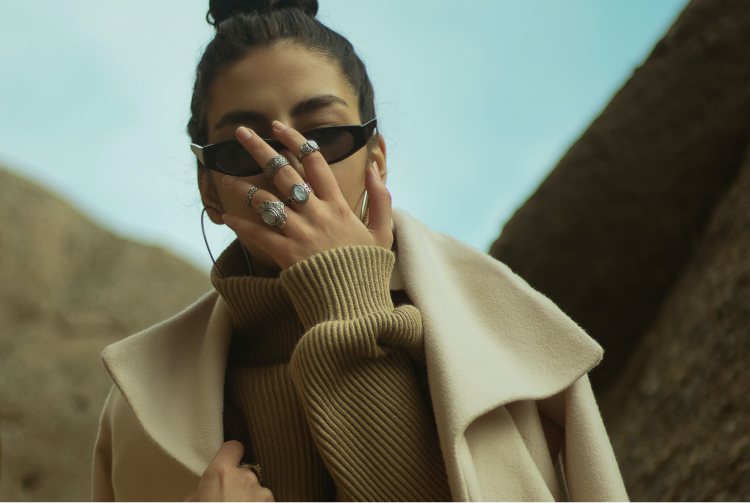80s punk fashion wasn’t just a trend. It was a cultural roar. A style born of rebellion, shaped by discontent, and amplified by music, this iconic look hollered individualism in a world that preached conformity. The legacy of those radical 80s punks can be found on today’s fashion runways, in your favorite vintage closet, and in the unapologetic spirit of those who wear their identities like a badge of dedication, loud and proud.
This fashion subgenre was about swaying the conversation loud and clear, from leather jackets to safety pins, tattered denim to bright mohawks. This blog describes punk fashions, including how they advanced, their challenges, and future trends.
Eighties Punk Style: The Aesthetic Of Rage
Punk was more than music in the late 1970s and early 1980s—it was a movement. In the U.K. and U.S., working-class youth turned their backs on the glamorous consumerism of disco and the palely soft aesthetics of commercial fashion. They needed something darker—something real.
Fashion became a political act. Clothes were slashed, patched, and pieced together not to impress but to disrupt.
Key early influences included:
- Vivienne Westwood and Malcolm McLaren (who outfitted the Sex Pistols)
- Punk rock groups such as The Ramones, Dead Kennedys, and The Clash
- DIY ethics that rejected mass production
Core Elements of 80s Punk Fashion
1. Leather & Denim Domination
It was punk’s armor: iconic black leather jackets covered in studs, patches and paint. Add some ripped, acid-wash jeans , and you had the de facto uniform of rebellion.
2. DIY Ethos
Punks didn’t buy fashion—they created it. Band logos hand-drawn on jackets, safety pins used as earrings, and duct tape replacing hems became a badge of authenticity.
3. Mohawks & Color
Hair was another canvas of rebellion. Mohawks, liberty spikes, and brightly dyed hair were common, often styled with excessive gel or glue.
4. Offensive Slogans & Anti-Logos
Clothes carried anti-establishment messages. Punks used ironic patches, inverted religious symbols, or even Nazi imagery (used to shock, not support) to rebel against societal norms.
Advancements in ’80s Punk Fashion
Though born from the underground, punk fashion didn’t stay there. Over time, it adapted and expanded into mainstream culture and high fashion, experiencing some surprising transformations.
1. From Underground to Runway
What once mocked fashion elites became featured by them:
- Vivienne Westwood’s 80s collections brought punk to Paris and Milan.
- Designers like Jean Paul Gaultier and Alexander McQueen referenced punk silhouettes and materials.
- Modern punk fashion became refined yet radical—an evolution from street to catwalk.
2. Commercialization of Punk Looks
Punk-inspired looks became available through retailers like Hot Topic, Urban Outfitters and Zara. You could buy pre-ripped jeans, faux leather jackets and punk-themed accessories without stepping in a mosh pit.
3. Technology & Punk Aesthetics
Punk DIY evolved with tech:
- Custom patches via digital printing
- Online punk clothing stores and Etsy shops
- Platforms like Depop and Instagram allow indie designers to showcase handmade punk pieces
Challenges Punk Fashion Faced Over the Years
While punk fashion grew in popularity, it also had to navigate some challenging issues.
1. Commercial Dilution
When rebellion becomes mass-produced, it can lose authenticity. Critics argue that commercial brands have watered punk’s original message, turning it into a costume rather than a cause.
2. Cultural Misappropriation
Punk’s visual language—once rooted in anti-racism, anti-capitalism, and gender nonconformity—has sometimes been misused by people unaware of its origins, leading to unintentional disrespect.
3. Subcultural Fragmentation
As punk fashion spread globally, it fractured into subgenres like:
- Pop-punk (Blink-182-style)
- Goth-punk
- Cyberpunk
- Hardcore/Anarcho-punk
Each had its aesthetic, causing community debates about what’s “true punk.”
Modern Revival: How Punk Still Shapes Today’s Fashion
80s punk fashion isn’t dead—it’s been reborn.
1. Influencing Gen Z
Young generations are rediscovering punk via:
- Thrift stores and vintage hauls
- DIY tutorials on TikTok and YouTube
- Political activism, mirroring punk’s core ethos
2. Fusion with Other Cultures
Punk fashion now fuses with:
- K-Punk: A Korean spin on classic punk with glam-rock edges
- Afro-Punk: Centering Black identity and resistance within punk culture
- Queer Punk: Merging fashion with gender fluidity and LGBTQ+ pride
3. Eco-conscious Punk
The DIY culture of the 80s has found a new relevance in sustainability. Many punks are now upcycling clothing, creating handmade patches, and rejecting fast fashion altogether.
Future Trends in Punk Fashion
Punk fashion is cyclical—it dies and revives stronger. Here’s what we may see ahead.
1. Tech-enhanced DIY
From LED spikes to 3D-printed accessories, expect a new wave of punk DIY infused with modern tech.
2. Punk Meets AI
Imagine virtual punk avatars, AI-generated album art, and augmented reality jackets. Punk may enter the metaverse while keeping its raw attitude.
3. Punk as Protest Wear
As global protests rise—from climate strikes to social justice marches—expect punk fashion to reappear as protest attire. Think gas mask accessories, anarchist patches, and graphic tees with QR codes linking to activist causes.
Brands & Artists Keeping 80s Punk Fashion Alive
1. Killstar & Disturbia
These modern brands reinterpret punk with goth and grunge elements, offering ethically made fashion for new rebels.
2. Celebs & Influencers
- Billie Eilish wears punk-styled oversized, genderless clothing.
- Machine Gun Kelly and Yungblud rock studded leather and colored mohawks.
- TikTok creators are bringing back punk in short-form style tutorials.
Is Punk Fashion Dead or Immortal?
Punk fashion may change shapes, but its core is eternal: resistance through style.
Even if you’re not standing in a mosh pit or yelling “Anarchy in the UK,” when you tear your jeans, spike your hair, or DIY your look, you’re carrying forward the spirit of 80s punk fashion.
FAQs – 80s Punk Fashion
Q1. What defined 80s punk fashion the most?
The aesthetic was defined by bold and rebellious looks that you’d see people wearing, including ripped clothing, leather jackets, DIY patches, colored mohawks and combat boots.
Q2. Was punk fashion the same in the US and UK?
While similar, UK punk leaned more towards political rebellion, while US punk often embraced skate and hardcore influences. The fashion was identical, but the context varied.
Q3. How do I make 80s punk style relevant to today?
Begin with thrift store clothes, band tees and leather or denim jackets, and customise them with pins, patches and slogans. Don’t be afraid to be loud!
Q4. Is 80s punk fashion making a comeback?
Absolutely! From high-fashion runways to indie streetwear brands and Gen Z’s DIY craze, punk is back in fresh, hybrid forms.
Q5. Was punk fashion political?
Very much so. It was rooted in anti-establishment ideas and often confronted capitalism, patriarchy, and societal norms.
Q6. What’s the difference between punk and goth fashion?
Punk is more anarchic and aggressive, using reds, blacks, and slogans. Goth leans toward mysticism, black lace, and romantic silhouettes.
Q7. Where can I buy modern punk clothes?
For authentic DIY-ready garments, try sites like Killstar, Etsy (for custom pieces), Dolls Kill, or secondhand shops.
Conclusion: Punk’s Not Dead—It’s Just Evolving
80s punk fashion may have started as a middle finger to the system, but it became something more over time. It’s a language. A form of non-verbal protest. A creative outlet. And for many, a way of life.
So whether you’re wearing spikes to your next concert or crafting your jacket at home, remember—you’re not just dressing up. You’re channeling decades of disruption, style, and fearless self-expression.
And that, in true punk fashion, is something no one can take from you.
Welcome to our blog. We encourage you to get in touch. Contact us



